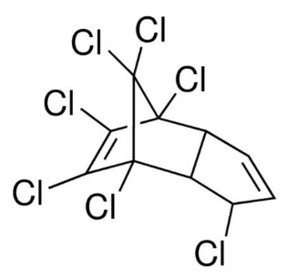Molecular Database
Heptachlor
MW = 373.32 g/mol
CAS Number: 76-44-8
Use and production
Heptachlor (1,4,5,6,7,8,8-Heptachloro-3a,4,7,7a-tetrahydro-4,7-methanoindene) is primarily used to kill soil insects and termites, heptachlor has also been used more widely to kill cotton insects, grasshoppers, other crop pests, and malaria-carrying mosquitoes.
Toxicity and POPs characteristics of heptachlor
Heptachlor is listed under Annex A in the Stockholm convention. It is believed to be responsible for the decline of several wild bird populations, including Canadian Geese and American Kestrels in the Columbia River basin in the US. The geese died after eating seeds treated with levels of heptachlor lower than the usage levels recommended by the manufacturer, indicating that even responsible use of heptachlor may kill wildlife. Laboratory tests have also shown high doses of heptachlor to be fatal to mink, rats, and rabbits, with lower doses causing adverse behavioral changes and reduced reproductive success.
Heptachlor is classified as a possible human carcinogen. Food is the major source of exposure for humans, and residues have been detected in the blood of cattle from the US and from Australia.



